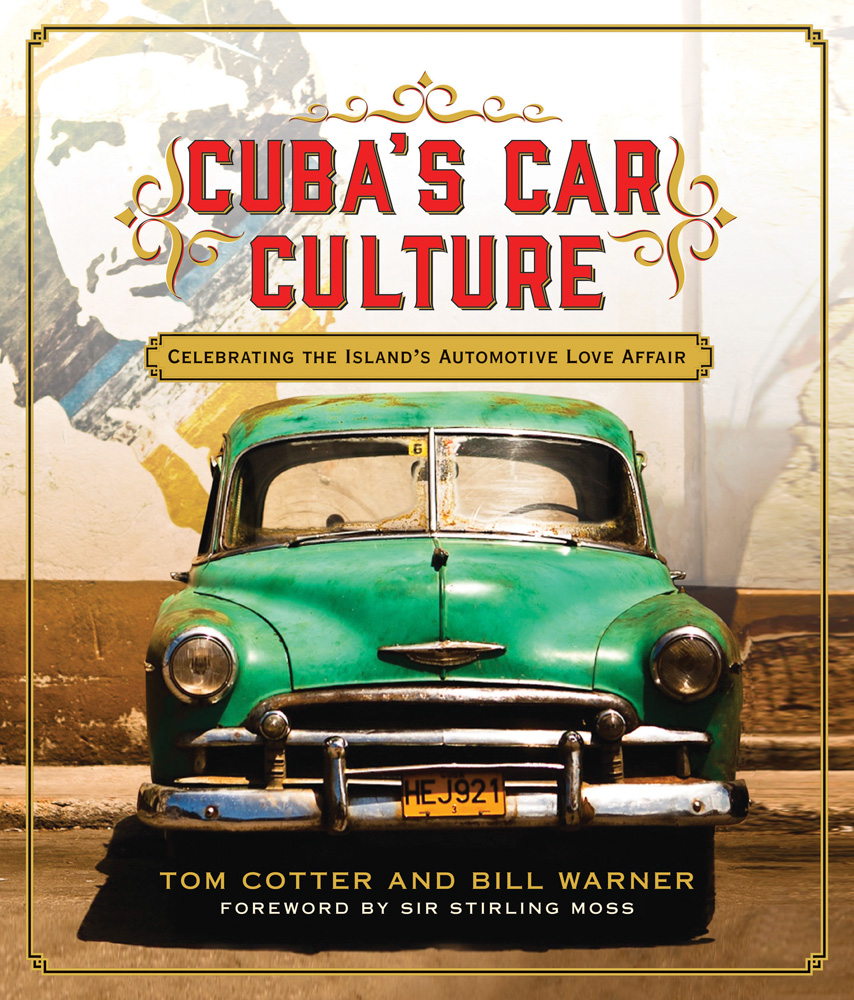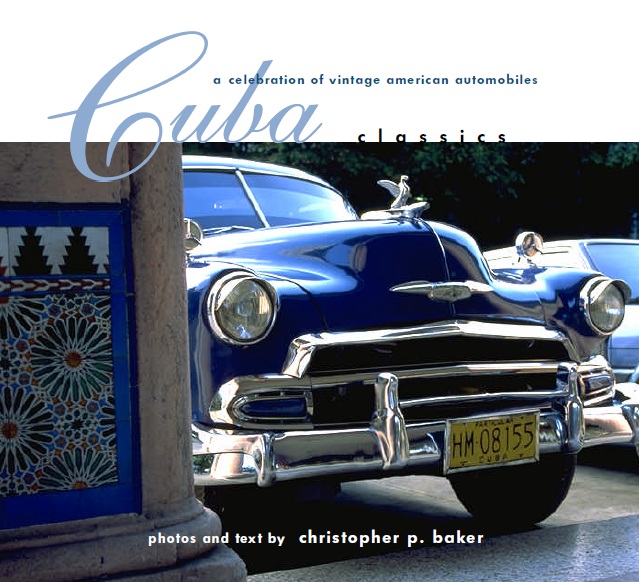It’s been a decade since my coffee-table book, Cuba Classics: A Celebration of Vintage American Automobiles, was published. A full decade in which Cuba’s plethora of far-from-museum-quality Detroit dowagers still rule the roads.
With the recent tsunami of interest in Cuba, the latest of several coffee-table books on the theme to be published seems timely. When Quarto Publishing’s marketing folks offered to send me a copy of Cuba’s Car Culture: Celebrating the Island’s Automotive Love Affair, by automotive experts Tom Cotter and Bill Warner, I was keen. I devoured it in one sitting last night.
 The use of a few top-quality photos purchased from Getty Images (including a splendid cover shot showing a Chevy Bel-Air juxtaposed against a Che Guevara mural) enhances the authors own street photography. Thus, the book is splendidly illustrated, including with Bill Warner’s own archival 1950s black-and-white imagery and fascinating yesteryear posters.
The use of a few top-quality photos purchased from Getty Images (including a splendid cover shot showing a Chevy Bel-Air juxtaposed against a Che Guevara mural) enhances the authors own street photography. Thus, the book is splendidly illustrated, including with Bill Warner’s own archival 1950s black-and-white imagery and fascinating yesteryear posters.
The twelve chapters span the spectrum from Cuba’s race-car history (an excellent and superbly illustrated strong suit) to “Leftover Classics,” profiling some of the island’s rarest-of-rare Porsche 356s and Mercedes 300SL roadsters and derelict Gullwings, etc.
Unfortunately, there’s no running theme to the text, which jumps backwards and forwards chronologically and thematically; and skims over or omits many all-important aspects of Cuba’s car culture (the early 20th-century history is well developed; but less so the all-important 1950s).
Still, it’s a fine book nonetheless. And Cotter and Warner have dug up some fascinating facts I never knew, courtesy not least my pal Eduardo Mesejo Maestre, director of Havana’s Museo del Automóvil (Car Museum), who helped show the authors around.
The book is a result of two brief visits that Cotter and Warner made in 2009 and 2015. By chance, I bumped into them during their 2009 visit, when we dined together with Eduardo. Ironically, the authors quote a “Chris Baker—a Brit living in Cuba.” But he appears not to be me.
 Since the authors’ time on the island was fleeting, their comprehension of Cuba is sometimes understandably half-baked. The average reader who isn’t familiar with Cuba won’t notice this, of course, nor will they care. But since a few erroneous statements help shape the readers’ perception of Cuba, I can’t help but correct them.
Since the authors’ time on the island was fleeting, their comprehension of Cuba is sometimes understandably half-baked. The average reader who isn’t familiar with Cuba won’t notice this, of course, nor will they care. But since a few erroneous statements help shape the readers’ perception of Cuba, I can’t help but correct them.
Right up front (in the second paragraph) of the Introduction, Cotter accuses Cuba of putting “millions of citizens into poverty.” Clearly, the Castro Revolution destroyed the upper and (economic) middle classes, and the Communist system is indeed an utter economic failure. But the Revolution also raised millions out of 1950s-era destitution and created a new (intellectual) middle class by eradicating illiteracy and spreading high culture to the masses. And during the Soviet period, when Kruschev & Co. gave Fidel whatever was needed, life was pretty good for most Cubans.
Cotter and Warner were viewing Cuba as it still attempts to regain traction after the devastating collapse of the Soviet Union (and they fail to understand the enormous impact of the U.S. embargo, the goal of which is to, er, put “millions of citizens into poverty”). Nothing about Cuba is black and white.
And we don’t get three pages into the text before we read of airport “guards holding machine guns.” The intent of the statement, repeated later in the book, is to paint Cuba as a brutal police state (legendary British race-car driver Stirling Moss, in his short introduction, indeed calls contemporary Cuba a “police state”). That spoiled it for me. First, it’s a stupid comment. I’ve passed through the same airport terminal more than one hundred times during the past 25 years and never seen “guards holding machine guns.” For a simple reason. They don’t exist! And duh… have the authors noticed the machine gun-toting police in Heathrow or JFK airports?
And then there’s this: “We were naïve… thinking we could actually ‘sneak’ around the capital… But once we saw the guards with machine guns around the city…” It’s a pity that Cotter and Warner would spoil an otherwise good book with such outrageously false, gratuitous, and politically motivated misrepresentation. Yes, the many police who patrol the streets do indeed carry pistols, just like in New York, Paris and now London. But take it from me, after two-and-a-half decades exploring Cuba the only machine-guns (actually semi-automatics) I’ve seen have been in the hands of Cuba’s Transval cash collectors, who operate like Brinks, with their armored trucks and semi-automatics slung at the hip.
Sorry, I digress…
So back to the cars. All in all it’s an excellent book and an enjoyable read, and one that would make a fine Christmas present… perhaps as a complement to my own Cuba Classics: A Celebration of Vintage American Automobiles.

